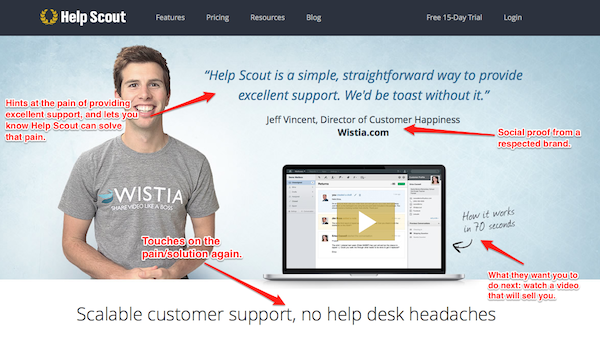Short Vs. Long Copy: 5 Guidelines to Help You Decide
It’s easy to find advice on how long copy should be.
It’s hard to find specific advice on how long copy should be.
You’ll see things like:
- It’s OK for it to be long, but not too long.
- The more expensive the product, the longer it should be.
- Well, it depends.
And you know what? There’s a reason why you usually don’t walk away with a definitive answer to this very common question.
There isn’t one.
Having said that, anytime I talk to fellow copywriters, they all seem to have some set of personal guidelines for how long to make something.
I happen to think I have a few guidelines that you may not have seen before.
In this post, I’m going to go through the information that guides me whenever I’m deciding how long to make something. You will not find me saying long is bad and short is good. You will simply find the guidelines that inform my copy.
Table of Contents
Short Vs. Long Guideline #1: When Can I See the Fire Hydrant?
Information can be a funny thing for us humans.
We are completely convinced that the more information we have available, the better the decisions we will make, despite the numerous examples of psychological and scientific evidence that say otherwise.
Take the fire hydrant experiment that Nassim Nicholas Taleb describes in his book The Black Swan, for example:
Show two groups of people a blurry image of a fire hydrant, blurry enough for them not to recognize what it is. For one group, increase the resolution slowly, in ten steps. For the second, do it faster, in five steps. Stop at a point where both groups have been presented an identical image and ask each of them to identify what they see. The members of the group that saw fewer intermediate steps are likely to recognize the hydrant much faster. Moral? The more information you give someone, the more hypotheses they will formulate along the way, and the worse off they will be. They see more random noise and mistake it for information.”
Of course, this is a hard exercise to duplicate in a blog post, but the two GIFs below will give you a decent idea of the experiment:
This is something I’ve started to keep in mind recently.
I write a bunch of copy, more than I know is necessary. Then I’ll imagine the “fire hydrant” as the moment when the prospect is convinced to take the action my copy is trying to get them to take.
That’s when I go back and get rid of anything that risks obscuring the “fire hydrant.”
Get it down to the essential information someone would need before buying your product—the pain they have, how it will solve that pain, proof it will solve that pain (if you have it), specific instruction on what they need to do next, etc.
Sometimes you can do all of that above the fold, like the folks at Help Scout do on their home page:

Sometimes it takes a long-form sales page.
The more you write, the more you’ll learn about when to use one versus the other.
Short Vs. Long Guideline #2: Accomplish something above the fold. Always. Add to it if necessary.
Whether you’re writing short form or long form, it’s always good to accomplish something above the fold.
Don’t just use a pretty picture.
Don’t use it as a “set up” for a big punch to come later.
Don’t mess around. Not when you’re above the fold.
What does that mean? Most of the time, it will mean having some type of “next step” action your prospect can be sold on and take without having to scroll. This could be anything from getting someone to opt in to an email list, to watching a video, to registering for a free trial, to viewing pricing, etc.
Then, below the fold, feel free to add more copy that you think will help your prospect see the fire hydrant better. The previous example, Help Scout, has plenty of additional information below the fold that helps answer the questions they know their ideal customers are asking.
All of that comes, however, after they cover the essentials above the fold.
Short Vs. Long Guideline #3: Let the design go to work for you.
When someone like LeadPages co-founder Clay Collins says, “Design is the copywriting,” it’s worth paying attention.
This doesn’t mean that copy is unimportant. It just means that a page designed with conversion in mind has a good chance of going toe-to-toe with an ugly page written by a superstar copywriter (there’s a great story about that in the previous link).
Length of copy is about more than just word count; it’s also about how long it will make the page once you add in all the design elements—images (which are often equally important), buttons, opt-in boxes, icons, arrows, etc.
Just remember, sometimes a few design tweaks can do more for your conversion rate than an extra paragraph or two.
I know it’s fun to tease designers, but it’s important not to count them out. ![]()
Short Vs. Long Guideline #4: You and I know nothing. Therefore, test.
Even though I labeled testing as a guideline, it’s really more of a must-do.
Why? Because testing is what informs guidelines.
It’s how you learn about your customers’ tendencies. It’s how you learn which best practices tend to work for you, and which don’t. It’s how you take one of the best converting pages out there…and then make it even better.
Short Vs. Long Guideline #5: Know thy audience.
It drives me crazy when someone points to a long-form sales page that made someone millions and decides to copy it expecting the same results.
I immediately want to ask that person:
- Is your page selling the same product?
- Is the exact same audience going to come to your page?
- Are you somehow going to go back in time so that same audience can view your page at the same exact time they viewed the first one?
- Do you know how visitors landed on that original page? Did they come from a webinar? An email? A Facebook ad? How were they prepared for it?
It’s so easy to construct a narrative fallacy based on the belief of “if X worked for so-and-so, it will work for me.” We like simple stories, so we invent one based on very little information and then base an entire marketing campaign around it.
What most don’t realize is that we miss a critical step when we make assumptions based on others’ results—after considering that X worked for so-and-so, we fail to ask, “How can I apply this to my product and customers?”
Instead of conforming your product and customers to someone else’s marketing, conform their marketing to your product and customers.
Stealing from the best is not always a bad strategy. Sometimes you really can take someone else’s template for a sales page, marketing funnel, or whatever it might be, plug in your copy, and see dramatic improvement.
The sweet spot, however, is usually stealing from the best…and then making it your own.
Don’t go long or short solely because someone else did. Go long or short because you know it’s what your audience will respond to. And if you’re not sure, test.
About a week ago I was flying back to Nashville from Minneapolis. The middle-aged guy next to me struck up a conversation that eventually fell on what we do for a living.
He was a programmer. I started asking questions about Python and WordPress and he confessed that he’s probably 10 years behind the current state of programming.
“I eventually couldn’t keep up with it anymore. Things are changing too quickly,” he said. “Plus, all my clients still like their stuff done the ‘old way’ anyway. It still works for them.”
The moral of the story? Don’t ever let someone tell you something like long copy is dead. It might be trending down (or it might not…who really knows?), but there will always be instances where it works.
So experiment. Test. Get to know your audience. Watch for the fire hydrant. Pay attention.
Eventually, you’ll know when you’ve gone on too long.
Question: What guidelines do you use for short vs. long copy?
About the author: Will Hoekenga

I’m a full-time copywriter for the awesome folks at LeadPages, which is seriously the best landing page creation and online lead-gen tool out there (trust me..I was a customer before I became part of the team).
Join me on copygrad.com




